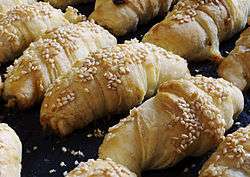Kifli
|
Two kiflis, the left one is salted | |
| Course | Dessert |
|---|---|
| Place of origin | Austria, Hungary, Serbia |
| Region or state | Balkan, Central Europe |
| Serving temperature | Baked |
| Main ingredients | Wheat flour |
|
| |
Kifli (Hungarian pronunciation: [ˈkifli], meaning "twist", "crescent") is a traditional European yeast roll made into a crescent shape.[1][2] The pastry is called kifli in Hungarian, rohlík in Czech, Kipferl in Austrian German, кифла/kifla in Serbian, kifla in Bosnian, corn in Romanian, рогалик/rogalik in Russian, рогалик/rohalyk in Ukrainian, кифла in Bulgarian, кифла in Macedonian, rožok in Slovak and rogal in Polish. In Danish and Swedish, it is called giffel.
Method
A kifli is made by cutting sheets of soft yeast dough into triangular wedges, then rolling this into a crescent shapes which are then baked. Kifli differs from the French croissant, again meaning "crescent") in that it is made from a plain, bread-like dough (thus being more akin to a roll than to pastry) and being both thinner and longer. They may also come in different sizes, some of them equalling in weight a small bread loaf.
Regular

When they come out of the oven, the rolls can be left plain or given a water brushing to make them shiny, or can be given an egg wash and sprinkled with either poppy seeds or caraway seeds mixed with coarse salt. The latter variety is often made into a straight shape, instead of curved like a crescent. Kifli is eaten like bread or rolls, usually made into a sandwich, sometimes plain or with butter like a fresh baguette. Often, especially for breakfast, the topping is jam or honey, or they may be used for dunking.
Fine
This is the same as the regular style, but the dough may contain butter or other shortening and/or milk. It is sweeter than the regular variety and is therefore especially well suited to be eaten with jam or honey, as is often done for breakfast with coffee, hot chocolate or milk. This might also be an accompaniment for drinks like Doogh or Kumis.
Sweets
There are a couple of sweet rolls that carry the name "kifli" to describe their shape but they are eaten at the end of a meal or with an afternoon tea or coffee and have nothing to do with kifli which, if the word is used on its own, always means the regular or fine varieties described above.
- vaníliás kifli is a small soft cookie made from a dough of ground nuts, instead of flour. It is usually made with walnuts but almonds are more often used outside of Hungary. Once baked they are rolled in vanilla flavored confectioners' sugar before allowed to cool.
- diós kifli, mákos kifli, also known as Pozsonyi kifli (Pozsony is the Hungarian name of Bratislava, capital city of the Slovak Republic) are crescent-shaped sweet leavened pastries filled with a sweet walnut or poppy paste. They are a variety of beigli, very similar in flavor but different in shape and size.
Origin
The Kipferl has been documented in Austria going back at least as far as the 13th century (first recorded as "chipfen").[3]
A common culinary myth claims that when Christian forces freed Buda from Ottoman occupation in 1683 the bakers of the town celebrated the victory the next day by selling freshly baked bread rolls made into a crescent shape. Another culinary legend claims that the Kipferl was invented in Vienna after or during the siege of the city by the Ottoman Turks.
Trivia
An early 1990s Hungarian pop group, Kifli, was named after this bakery specialty.
Process of kifli production
- Process of kifli production
.jpg) 1/12 Loaves of dough before splitting
1/12 Loaves of dough before splitting- 2/12 Small chunks of dough
- 3/12 Dough before insertion into kifli machine
- 4/12 Inserting dough, machine rolls kifli automatically
- 5/12 Rolled kiflis before baking
- 6/12 Creative variations
- 7/12 Proofing before baking
- 8/12 Watering a kifli
- 9/12 Sprinkling with poppy
- 10/12 Salt and cumin variation
- 11/12 Kiflis in front of steam furnace
- 12/12 Baked kiflis before distribution
See also
- Vanillekipferl, a feature of Austrian cuisine
- Rogal świętomarciński, a crescent cake baked in Poznań, Poland, for St. Martin's Day
References
| Wikimedia Commons has media related to Kipferl. |
- ↑ Kifli
- ↑ definition
- ↑ Jacob and Wilhelm Grimm, Kipfel, entry in their Deutsches Wörterbuch
Recipe
| Wikibooks Cookbook has a recipe/module on |
